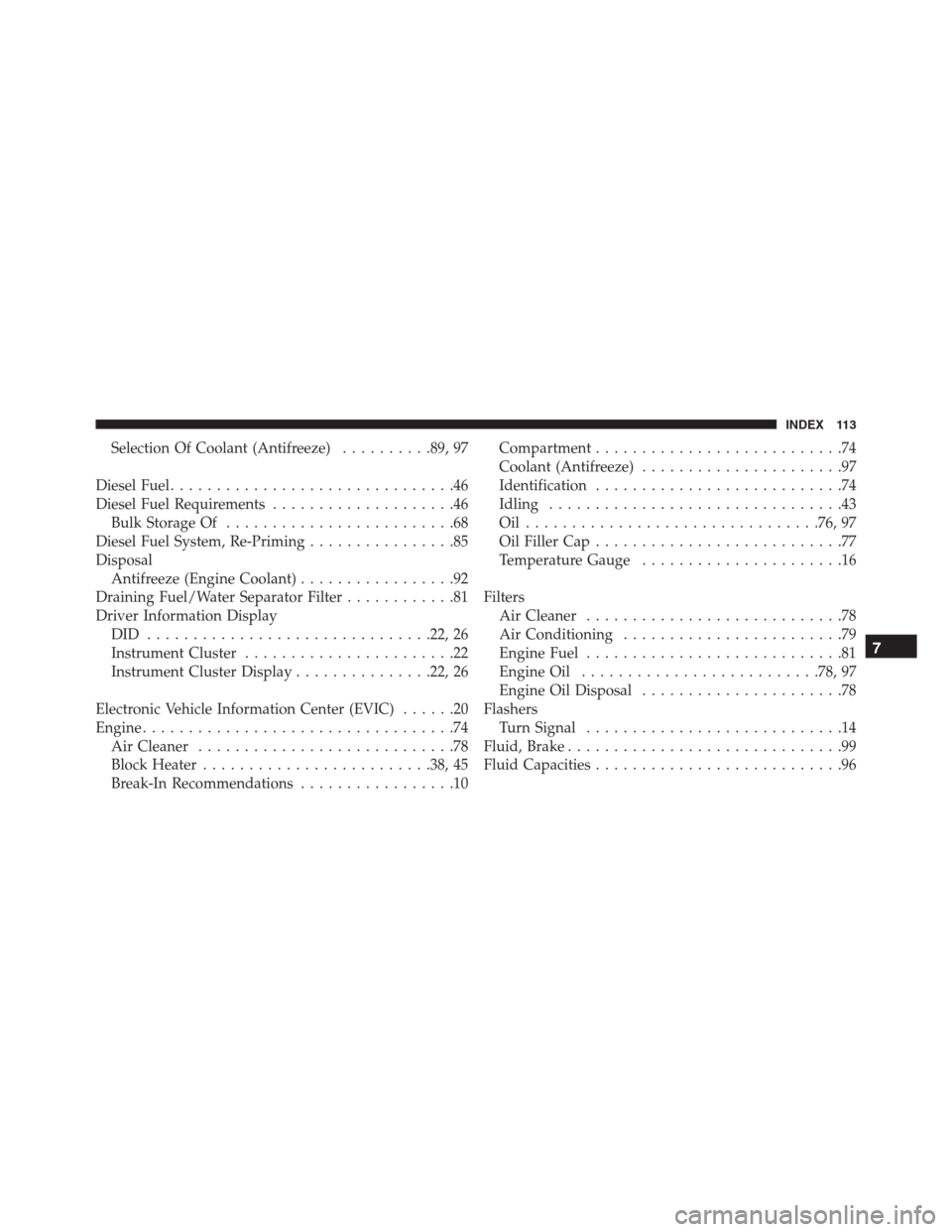Page 95 of 120

Points To Remember
NOTE:When the vehicle is stopped after a few miles/
kilometers of operation, you may observe vapor coming
from the front of the engine compartment. This is nor-
mally a result of moisture from rain, snow, or high
humidity accumulating on the radiator and being vapor-
ized when the thermostat opens, allowing hot engine
coolant (antifreeze) to enter the radiator.
If an examination of your engine compartment shows no
evidence of radiator or hose leaks, the vehicle may be
safely driven. The vapor will soon dissipate.
•Do not overfill the coolant expansion bottle.
•Check the coolant freeze point in the radiator and in
the coolant expansion bottle. If engine coolant (anti-
freeze) needs to be added, the contents of the coolant
expansion bottle must also be protected against freez-
ing.•If frequent engine coolant (antifreeze) additions are
required, the cooling system should be pressure tested
for leaks.
•Maintain engine coolant (antifreeze) concentration at a
minimum of 50% OAT coolant (conforming to
MS.90032) and distilled water for proper corrosion
protection of your engine which contains aluminum
components.
•Make sure that the coolant expansion bottle overflow
hoses are not kinked or obstructed.
•Keep the front of the radiator clean. If your vehicle is
equipped with air conditioning, keep the front of the
condenser clean.
•
Do not change the thermostat for Summer or Winter
operation. If replacement is ever necessary, install ONLY
the correct type thermostat. Other designs may result in
unsatisfactory engine coolant (antifreeze) performance,
poor gas mileage, and increased emissions.
5
MAINTAINING YOUR VEHICLE 93
Page 96 of 120

Charge Air Cooler — Inter-Cooler
The charge air cooler is positioned in front of the radiator
and the air conditioner condenser. Air enters the engine
through the air cleaner and passes through the turbo-
charger, where it is pressurized. This pressurized air
rapidly reaches high temperature. The air is then directed
through a hose to the charge air cooler and through
another hose to the intake manifold of the engine. This
cooling process enables more efficient burning of fuel
resulting in fewer emissions.
To guarantee optimum performance of the system, keep
the surfaces of the charge air cooler, condenser and
radiator clean and free of debris. Periodically check the
hoses leading to and from the charge air cooler for cracks
or loose clamps resulting in loss of pressure and reduced
engine performance.
Brake System
Brake Master Cylinder — Brake Fluid Level Check
The fluid level of the master cylinder should be checked
when performing under the hood service, or immedi-
ately if the “Brake System Warning Light” indicates
system failure.
The brake master cylinder has a translucent plastic
reservoir. On the outboard side of the reservoir, there is a
“MAX” mark and a “MIN” mark. The fluid level must be
kept within these two marks. Do not add fluid above the
full mark because leakage may occur at the cap.
With disc brakes, the fluid level can be expected to fall as
the brake linings wear. However, an unexpected drop in
fluid level may be caused by a leak and a system check
should be conducted.
Refer to “Fluids, Lubricants, And Genuine Parts” in
“Maintaining Your Vehicle” for further information.
94 MAINTAINING YOUR VEHICLE
Page 106 of 120
At Every Oil Change Interval As Indicated By Oil Change Indicator System:
•Change oil and filter.
•Completely fill the Diesel Exhaust Fluid tank.
•Drain water from fuel filter assembly.
•Rotate the tires.Rotate at the first sign of irregular wear, even if it occurs before the oil indicator system
turns on.
•Inspect battery and clean and tighten terminals as required.
•Inspect automatic transmission fluid if equipped with dipstick.
•Inspect brake pads, shoes, rotors, drums, hoses and park brake.
•Inspect engine cooling system protection and hoses.
•Inspect exhaust system.
•Inspect engine air cleaner if using in dusty or off-road conditions.
104 MAINTENANCE SCHEDULE
Page 108 of 120
Mileage or time passed (whichever comes
first)
10,000
20,000
30,000
40,000
50,000
60,000
70,000
80,000
90,000
100,000
110,000
120,000
130,000
140,000
150,000
Or Years: 1 2 3 4 5 6 7 8 9 10 11 12 13 14 15
Or Kilometers:
16,000
32,000
48,000
64,000
80,000
96,000
112,000
128,000
144,000
160,000
176,000
192,000
208,000
224,000
240,000
Additional Maintenance
Drain water from fuel filter assembly. X X X X X X X X X X
Replace fuel filters and drain water from the fuel
filter assembly.XX X X X
Replace engine air filter. X X X X X
Replace the air conditioning filter. X X X X X X X X X X X X X X X
Flush and replace the engine coolant at 10 years
or 150,000 miles (240,000 km) whichever comes
first.XX
Replace accessory drive belt(s). X
Change transfer case fluid.X
106 MAINTENANCE SCHEDULE
Page 114 of 120

Adding Engine Coolant (Antifreeze).............90
Adding Fuel..............................65
Air Bag Light.............................21
Air Cleaner, Engine (Engine Air Cleaner Filter).....78
Air Conditioning Filter......................79
Alarm (Security Alarm)......................21
Antifreeze (Engine Coolant)...................89
Capacities.............................96
Disposal..............................92
Anti-Lock Warning Light.....................13
Automatic Transmission
Fluid Type.............................99
Axle Fluid...............................99
Battery.................................87
Brake Fluid..............................99
Brake System.............................94
Fluid Check............................94
Master Cylinder.........................94Warning Light..........................17
Capacities, Antifreeze (Engine Coolant)...........96
Capacities, Fluid...........................96
Caps, Filler
Oil (Engine)............................77
Radiator (Coolant Pressure).................92
Charge Air Cooler.........................94
Coolant Pressure Cap (Radiator Cap)............92
Cooling System...........................88
Adding Coolant (Antifreeze)................90
Coolant Capacity........................96
Coolant Level...........................88
Disposal Of Used Coolant..................92
Drain, Flush, And Refill...................89
Points To Remember......................93
Pressure Cap...........................92
Radiator Cap...........................92
112 INDEX
Page 115 of 120

Selection Of Coolant (Antifreeze)..........89, 97
Diesel Fuel...............................46
Diesel Fuel Requirements....................46
Bulk Storage Of.........................68
Diesel Fuel System, Re-Priming................85
Disposal
Antifreeze (Engine Coolant).................92
Draining Fuel/Water Separator Filter............81
Driver Information Display
DID ...............................22, 26
Instrument Cluster.......................22
Instrument Cluster Display...............22, 26
Electronic Vehicle Information Center (EVIC)......20
Engine..................................74
Air Cleaner............................78
Block Heater.........................38, 45
Break-In Recommendations.................10Compartment...........................74
Coolant (Antifreeze)......................97
Identification...........................74
Idling................................43
Oil................................76, 97
Oil Filler Cap...........................77
Temperature Gauge......................16
Filters
Air Cleaner............................78
Air Conditioning........................79
Engine Fuel............................81
Engine Oil..........................78, 97
Engine Oil Disposal......................78
Flashers
Turn Signal............................14
Fluid, Brake..............................99
Fluid Capacities...........................96
7
INDEX 113